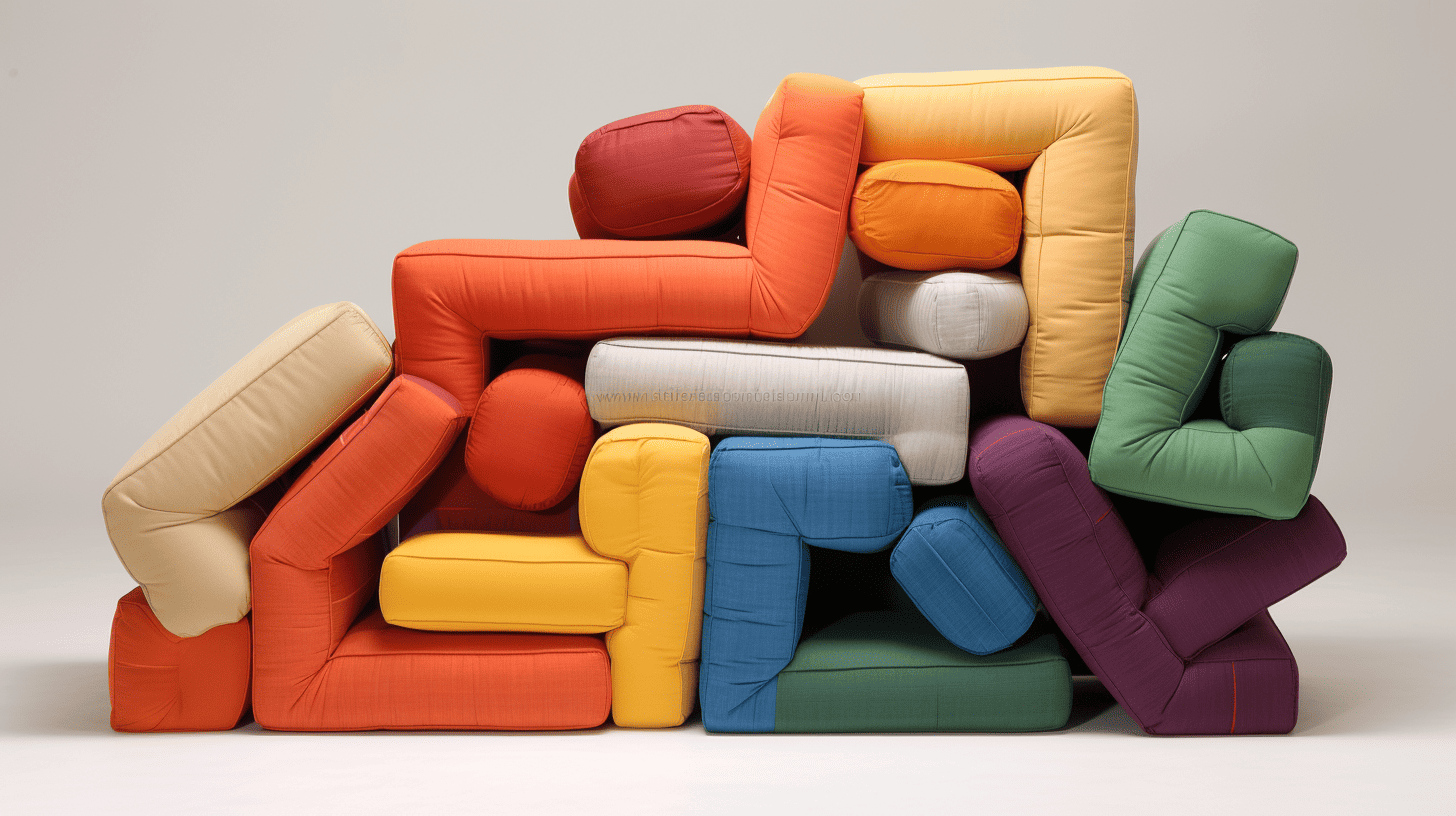Here at Couch.com we get questions about cushions a lot. It’s rare that someone is completely satisfied with their cushioning- it can be difficult (and sometimes lucky) to break in cushions evenly to a place where all sitters are satisfied. Here are some of the most frequently asked questions we hear when talking to folks about furn.
Can you put plywood under couch cushions?
Absolutely! Adding plywood under couch cushions is a clever trick to provide extra support and prevent sagging. It’s a simple DIY solution that can work wonders for revitalizing your couch. Here’s why it’s a great idea:
- Enhanced support: Plywood distributes weight evenly, preventing cushions from sinking and ensuring a more comfortable seating experience.
- Increased durability: By reducing stress on the cushions, plywood helps extend their lifespan and keeps your couch looking and feeling great for longer.
- Easy installation: Measure the seat area, cut the plywood to size, and place it securely under the cushions. Voila! Instant reinforcement.
Remember to use sturdy plywood that is at least ¾ inch thick. So go ahead and give your couch a well-deserved boost with this simple plywood hack for a better cushion couch.
Why does sofa go flat?
Have you ever wondered why your beloved couch seems to lose its plushness over time? Here are the main culprits:
- Regular use: Daily lounging, jumping, or even hosting Netflix marathons can gradually compress the cushion material, leading to a flatter appearance.
- Age and wear: Over time, the foam or filling inside the cushions can break down, losing its bounce and resilience.
- Quality matters: Cheaper sofas often come with lower-quality cushion materials, making them more susceptible to flattening.
But don’t despair! There are a few solutions at your disposal:
- Fluff and rotate: Give your cushions a good manual fluff every so often to redistribute the filling and restore their shape.
- Invest in quality: Consider purchasing sofas with high-density foam or durable cushion materials that are designed to resist flattening. Cheap couches = cheap foam.
- Replace or refill: If your cushions are beyond redemption, you can opt to replace them entirely or refill them with new foam or batting to bring back their fullness.
How often should I flip my couch cushions?

Flipping your couch cushions is a simple yet effective way to keep your seating experience fresh and comfortable. Here’s the scoop:
- Every few weeks: It’s a good practice to flip your couch cushions every few weeks to ensure even wear and maintain their shape.
- Rotate for balance: While you’re at it, rotate the cushions from left to right as well. This helps distribute pressure evenly, preventing any one area from flattening too quickly.
- Spot clean if necessary: Take this opportunity to spot clean any spills or stains on the underside of the cushions. A little TLC goes a long way!
By flipping and rotating your couch cushions regularly, you’ll extend their lifespan, keep them looking fabulous, and make sure your seating experience remains as cozy as ever.
Should I wrap my couch in plastic?
This one we have a pretty definitive and possibly provocative answer for: that’s a big “NO”. Would you wrap a pair of shoes in plastic when you wear them so they don’t get dirty? Not really… so why wrap your sofa! However, here are some of the reasons behind it (if you’re curious):
- Moisture prevention: Wrapping your couch in plastic can shield it from accidental spills or pet-related accidents, keeping the fabric or upholstery safe and dry.
- Dust and dirt defense: By encasing your couch in plastic, you create a barrier against dust, pollen, and other unwanted particles that can accumulate over time.
- Temporary usage: If you’re storing your couch for a short period or during a home renovation, wrapping it in plastic can provide extra protection against scratches, dings, or damage.
However, it’s important to consider a few factors as well:
- Breathability: Plastic covers can trap moisture, potentially leading to mold or mildew growth. Ensure proper ventilation if you choose to wrap your couch.
- Aesthetic impact: Plastic coverings might… well… they might look horrible. There are better options out there like some great colorful couch covers for cushions.
What happens to a couch when you sleep on it?
You just got a new small sectional sofa. It’s 9pm and then next thing you know it’s 6:47am…we’ve all been there. Let’s un-snooze some of the specific things that happen to a couch when you sleep on it too much:
- Compression: The constant weight and pressure from your body cause the cushion material to compress over time, resulting in a flatter and less supportive surface.
- Indentations: As you sleep in your favorite spot, the cushion fibers may begin to conform to the shape of your body, creating permanent indentations in the fabric.
- Wear and tear: Frequent use, including sleeping, can accelerate the general wear and tear on your couch, leading to potential issues like sagging springs or worn-out upholstery.
But fret not! There are a few solutions at your disposal to keep your couch in tip-top shape:
- Rotate and fluff: Regularly rotate the cushions and give them a good fluff to distribute the weight and plump up the cushions.
- Invest in quality: Choosing a high-quality couch with durable materials can help mitigate the effects of constant sleeping and ensure long-lasting comfort.
- Consider a sleeper sofa: If you find yourself frequently snoozing on your couch, investing in a dedicated sleeper sofa or sleeper sectional might be a worthwhile option. Sometimes you just gotta call a spade a spade.
Why do cushions wobble?
The concept of cushion “wobbling” generally refers to a cushion being lumpy or uneven or possibly prone to slipping and jostling around more than you want it to. Here are some reasons why this might be happening:
- Unbalanced stuffing: The filling inside the cushion can shift over time, creating an uneven distribution and leading to wobble.
- Sagging support: The framework beneath the cushion may weaken or sag, causing the cushion to wobble precariously.
- Unwarranted wear and tear: Constant use and pressure on the cushion can gradually wear it down, making it less stable.
There are solutions to bring that wobble to a halt:
- Fluff it up: Give your cushions a good fluff, redistributing the stuffing to restore balance and stability.
- Reinforce the frame: If the wobble is due to a sagging support structure, reinforcing the frame can provide newfound stability.
- Consider cushion grippers: Non-slip cushion grippers or adhesive pads can be placed under the cushions to keep them in place, preventing any wobbling mishaps.
Get ready to embrace stability like never before! Happy cushion adventures!
How do you tighten couch springs?

So, you’ve noticed a bit of sag in your trusty couch springs and you’re ready to get your toolbelt on. Don’t worry, you’re about to embark on an exciting journey that will have your couch feeling as bouncy as ever! Here’s what you need to do:
- Watch videos on how to do this because it would be quite foolish not to. Duh.
- Prepare for greatness: Gather the necessary tools like pliers, a screwdriver, and some muscle power. You got this!
- Locate the culprit: Flip your couch upside down (carefully, now) and identify the loose or sagging springs.
- Get ’em tight: Using your pliers, tighten the coil of each spring by rotating it in a clockwise direction. Don’t be afraid to give it a good firm twist!
- Secure the victory: If any springs have detached from the frame or become loose, use your screwdriver to reattach or tighten them back in place.
Remember, mighty upholstery warrior, this process requires a bit of strength and determination. But it may just be what Dr. Sofa ordered. Or maybe it’s just time to call a professional because it would likely be a lot easier for most people to just do that.
How do you keep chair cushions in place? How do you secure a cushion?
It’s time to embark on a quest to conquer the wandering chair cushion syndrome and restore order to your seating kingdom. Lucky for you, we come bearing tips that will keep those fluffy cushions exactly where they belong – under your royal derriere!
- Anti-slip wonders: Invest in non-slip grippers or adhesive pads specifically designed for chair cushions. These magical marvels will adhere to both the chair seat and cushion, preventing any slippage, even during the most enthusiastic chair sittings.
- Tie it up: Some cushions come with ties attached to their corners or sides. Simply tie them securely around the chair frame or legs. Not only will they keep your cushions in place, but they also add a charming touch to your seating ensemble.
- Grip and Velcro: Utilize self-adhesive hook and loop fasteners like Velcro. Attach one side to the chair seat and the other to the cushion for a snug and secure hold. Say goodbye to cushion drift!
How do you put ties on cushions?
If you’re ready to embark on a cushion-saving mission, we’re here to guide you through the exciting world of ties and couch cushion stability. Don’t worry, it’s easier than it sounds. Here are the broad strokes:
- Gather your supplies: You’ll need some sturdy fabric for the ties, a sewing machine or needle and thread, scissors, and measuring tape.
- Measure and cut: Measure the length you want your ties to be, usually around 8-10 inches. Cut strips of fabric accordingly, making sure they are about 1-2 inches wide.
- Prepare the ties: Fold each fabric strip in half lengthwise and press it flat. Then fold the edges towards the center, press again, and sew along the open edge to create a neat, finished tie.
- Attach the ties: Sew or hand-stitch the ties to the corners or sides of your couch cushions, making sure they are securely fastened. Leave enough length for tying them around the couch frame or legs.
With this cushion-saving DIY adventure, you’ll keep those fluffy cushions exactly where they belong – snug and secure!
How do you keep scatter cushions from slipping off a leather couch?
No more slipping toss pillows and scatter cushions on your beautiful leather couch! Say goodbye to the frustration of constantly readjusting those scatters (which are loose throw pillows) and embrace a stable and stylish seating experience.
- Velcro magic: Grab self-adhesive hook and loop fasteners like Velcro, which can easily be attached to both your couch and cushions.
- Get centered: Place one side of the Velcro on the underside of your cushions and the corresponding side on the couch surface. This will create a strong, secure bond that keeps your cushions in place, even during the most… um… “enthusiastic” sofa sessions.
- Film fix: Another clever trick is using silicone shelf liner or rubber matting. Cut it to fit the size of your cushions and place it underneath. This textured surface provides grip, preventing slippage while adding an extra layer of cushioning comfort.
The above options may not make sense for smaller toss pillows and cushions but hopefully it sparks an idea or two in your mind so that you can take a proactive approach to keeping those bad boys stationary.
How do you put Velcro on a couch cushion?
Velcro might be the best thing invented. It keeps our shoes on, keeps our bags closed, and keeps our command strips on the wall (so we don’t actually have to be adults and hang things with nails). Here’s how to use it on the bottom of a couch seat cushion to keep it in place. This usually applies to leather but it might be worth considering for slippery fabric sofas too.
- Prepare for the mission: Gather your supplies, including self-adhesive hook and loop fasteners like Velcro, a pair of scissors, and some cleaning wipes.
- Measure and cut: Cut the Velcro into strips that are about 2-3 inches long. You’ll need two strips for each cushion.
- Clean and attach: Wipe the desired spot on your couch cushion to ensure it’s clean and dry. Peel off the backing from one side of the Velcro strip and firmly press it onto the cushion surface. Repeat this process for the other side of the Velcro, making sure they align perfectly.
- Connect and enjoy: Now, attach the corresponding Velcro strips to your couch surface, aligning them with the ones on the cushion. Press firmly to create a strong connection.
Voila! The Velcro magic will keep your cushions securely in place, allowing you to relax and enjoy your seating oasis without any slipping mishaps.
Hopefully some of your cushion curiosity has been satisfied! Don’t forget to keep your couch nice and clean too. Here’s a Couch.com guide on how to clean couch cushions and also one on the top ways to take care of your new couch!

